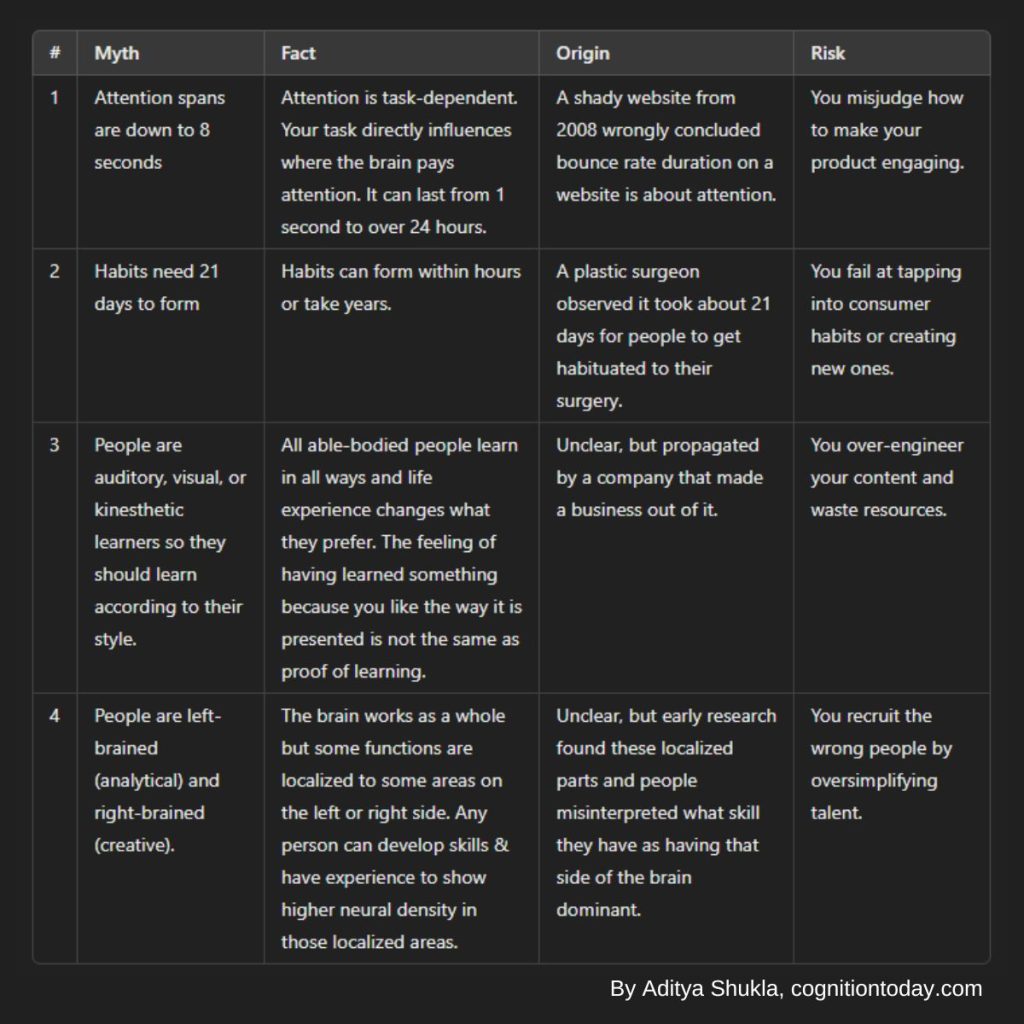Some psychology myths have gained immortal fact status in the business world. The reason for this is that misinformation appears believable, the myths are often repeated, and they fit into some actionable business idea via the confirmation bias.
Let’s look at 4 such. I’ve shared some of my consulting experiences, too.

1. Myth: Attention spans are down to 8 seconds.
Fact
Attention is task-dependent. Your task directly influences where the brain pays attention. It can last from 1 second to over 24 hours. Depending on your skill, the task’s demands, your interest, the reward for doing a task, and your emotions about the task, your attention & concentration will change.
Origin
A shady website from 2008 wrongly concluded bounce rate duration on a website is about attention. The specific measurement conclusion was that it takes about 8 seconds for people to exit websites they find useless or of low value.
Risk
You misjudge your content strategy.
I had a consulting gig for content strategy, right after I started blogging. This was a digital marketing agency that had D2C business clients. The meeting was centered around the idea that attention span is reducing and it is just about 8 seconds.
I asked them, “where did you hear that?” One guy said everyone knows; it’s obvious, many marketing gurus have said this. Another guy googles and shows me a rich snippet of “Attention span is 8 seconds, less than that of a goldfish.”
I tell them, the problem is not attention span. The problem is people expect things to be fast. Attention span is the same as it always was – it is task-dependent. That’s why you can scroll reels and YT shorts for hours, binge-watch TV shows, read books, etc., all day long. If you don’t like something, your brain avoids it because it knows moving on will mostly get you something you like immediately (thanks, lord Algorithm).
I concluded with the idea that their strategy should be centered around providing value that is packaged in a way their audience likes. If it is long content, give long content. If it is YouTube shorts, give them that. If they want video tutorials, give them that – Worry less about attention and more about immediately perceived value.
2. Myth: Habits need 21 days to form.
Fact
Habits can form within hours or take years. It depends on the ease of habit, the reason for doing the habit, the complexity of the habit, the benefits vs. cost of the habit, etc. Multiple studies have corroborated this.
Origin
A plastic surgeon observed it took about 21 days for people to get habituated to their surgery.
Risk
You fail at tapping into consumer habits or creating new ones.
Consider this. If you believe this myth – does it mean that a good marketing campaign should last less than 21 days so that users don’t get habituated to it? Does it mean after habituation users will ignore it? The answer is yes; users may ignore an ad after habituation, but that habituation can happen in 3 days or 100 days, depending on frequency.
Consider daily operations in a company. Will employees get into the habit of giving daily updates if they are forced to do it for 21 days? No. The moment it stops being mandatory, some employees will stop.
3. Myth: People are auditory, visual, or kinesthetic learners so they should learn according to their style.
Fact
All able-bodied people learn in all ways and life experience changes what they prefer. The feeling of having learned something because you like the way it is presented is not the same as proof of learning. The idea that people have learning style and that giving instructions to them as per their style enhances learning is called the meshing hypothesis, which has been rejected over and over again through experiments.
Origin
Unclear, but propagated by companies that made a business out of it with assessments. They themselves were following early trends in research on learning in the 70s & 80s. Unfortunately, that research, due to its lack of validation, steered them in the wrong direction.
Risk
Your analytics become meaningless and you waste resources pursuing a false goal.
I consulted an industry leader to build a school in Pune, India for underprivileged students a few years ago. They had the funds, the real-estate resources, the social respect, and a strong network. But I’ve seen that very few are willing to make decisions about the contents of education, the method of teaching, etc., The management involved there hired an app development company to make a brilliant app to assess students. The contents of the app, the analytics, etc., were seamlessly solved. The app worked, people loved it, and teachers loved it. When I met their stakeholders to help with their philosophy and teaching methodology, I saw this app. Brilliantly executed, but unfortunately, fully wrong – it was based on the learning styles myth. An intuitive myth living for decades – that students are visual, auditory, or kinesthetic learners and matching instruction to their personal style enhances education.
Unfortunately, I had to advice – the app analytics are essentially meaningless and this myth is widespread, so much that the best educators believe it to be true. Because, intuition. Research has repeatedly, for the 100th time, proven the myth to be false. I recommended capturing more stable data like cognitive functioning, exam performance, etc., and customizing instruction for diversity instead of bucketing.
4. Myth: People are left-brained (analytical) and right-brained (creative).
Fact
The brain works as a whole but some functions are localized to some areas on the left or right side. Any person can develop skills & have experience to show higher neural density in those localized areas. A study tested if there is a left-right difference[1] between people and used 1000+ people’s brain scans as their sample. They found no broad left-brainness vs. right-brainness, and no gender differences either. Their study supports the original fact which got corrupted into the myth. The fact is – that different cognitive functions like language, music, numerical skills, creativity, visual perception, etc., are governed by different brain regions.
Origin
Unclear, but early research found these localized parts and people misinterpreted what skill they have as having that side of the brain dominant.
Risk
You recruit the wrong people by oversimplifying talent.
Imagine there is a consulting company that takes private sector and R&D projects. One of their screening test for in-house consultants is a test that classifies people as Left-brained & Right-brained. They’ve developed this at a high cost and use it regularly. They also use it to assign interns to a project. The company realizes that the project teams get biased. Teams where creativity was needed started getting interns who were better at accounting and budgeting. Teams, where logic and analysis were needed have great communicators but inadequate data reporting. The problem here is people were assigned based on a flawed premise.
Let’s take this further let’s say the test questions were indeed uniquely classified as analytical vs. creative. The analytical tests also looked at other incorrect left-brain properties such as language, numerical analysis, design thinking, etc. The creative tests looked at art, drawing, poetry, musical perception, etc.
The fundamental problem is being analytical and being creative are not mutually exclusive traits. Neither are language and numerical analysis, or musical perception and design. These are independent competencies that can be tested with a strong relationship with other competencies. And from the actual work point of view, just a few of these competencies are not sufficient. Employees need more to work through a whole project. If new hires lack required skills because the test claimed they are a good fit, there is a burden on the company for re-skilling, a burden on the employee that leads to contract termination, and overall difficulty in completing the project.
At a glance

Now that you know these 4 myths, see if you can spot a few more in the test below.
Sources

Hey! Thank you for reading; hope you enjoyed the article. I run Cognition Today to capture some of the most fascinating mechanisms that guide our lives. My content here is referenced and featured in NY Times, Forbes, CNET, and Entrepreneur, and many other books & research papers.
I’m am a psychology SME consultant in EdTech with a focus on AI cognition and Behavioral Engineering. I’m affiliated to myelin, an EdTech company in India as well.
I’ve studied at NIMHANS Bangalore (positive psychology), Savitribai Phule Pune University (clinical psychology), Fergusson College (BA psych), and affiliated with IIM Ahmedabad (marketing psychology). I’m currently studying Korean at Seoul National University.
I’m based in Pune, India but living in Seoul, S. Korea. Love Sci-fi, horror media; Love rock, metal, synthwave, and K-pop music; can’t whistle; can play 2 guitars at a time.



























